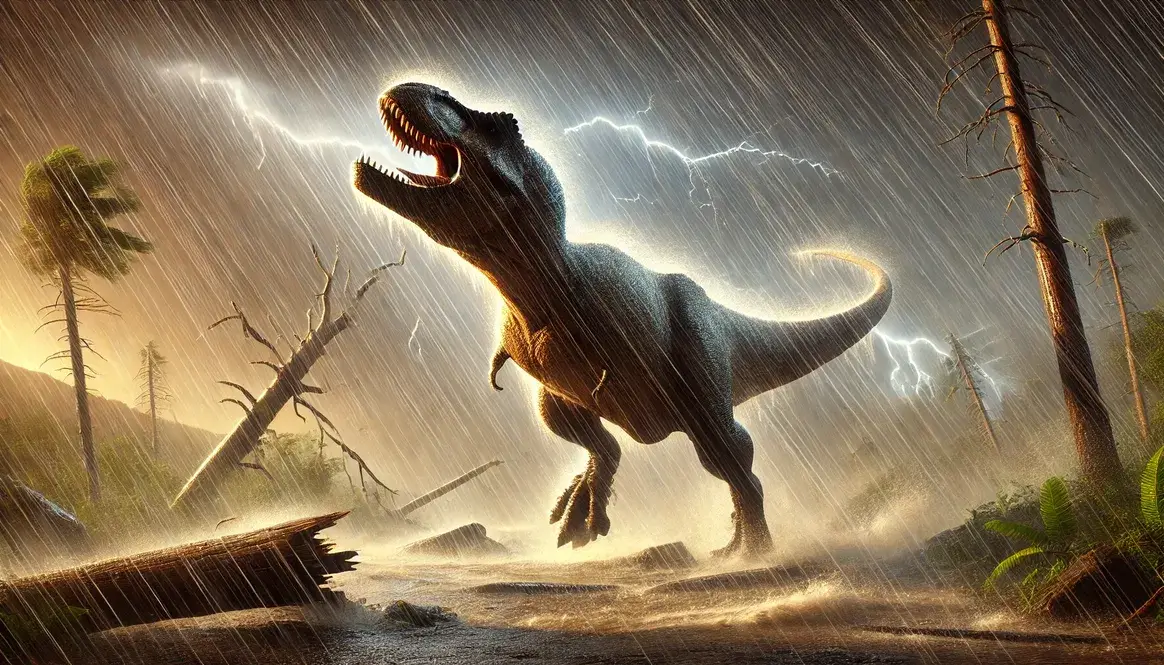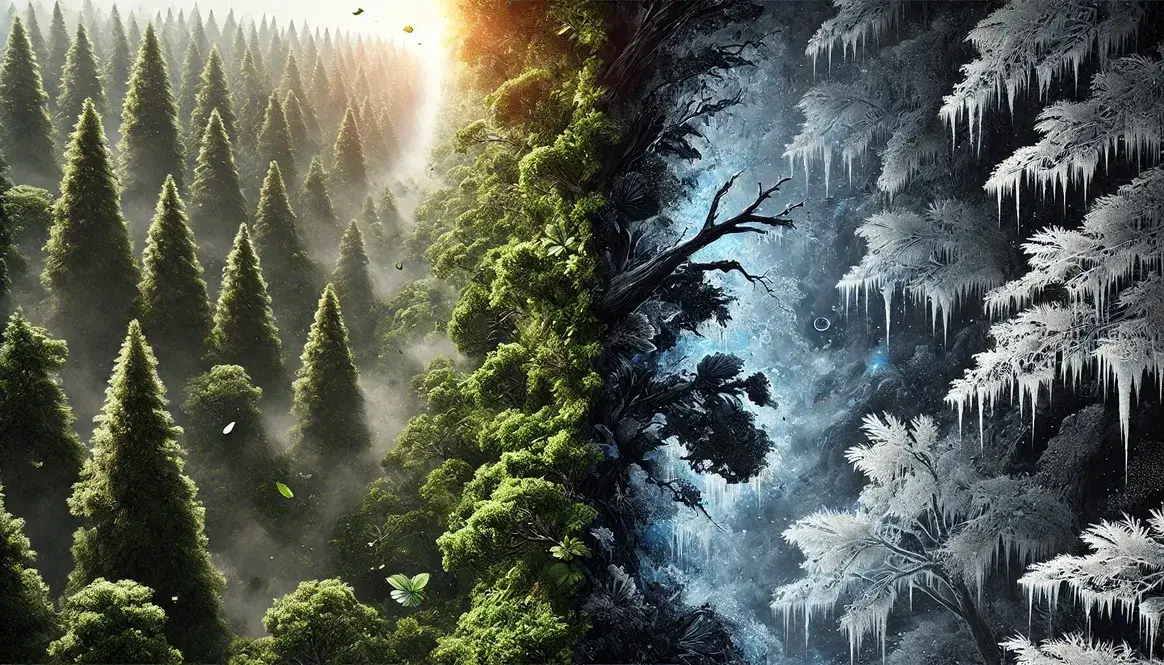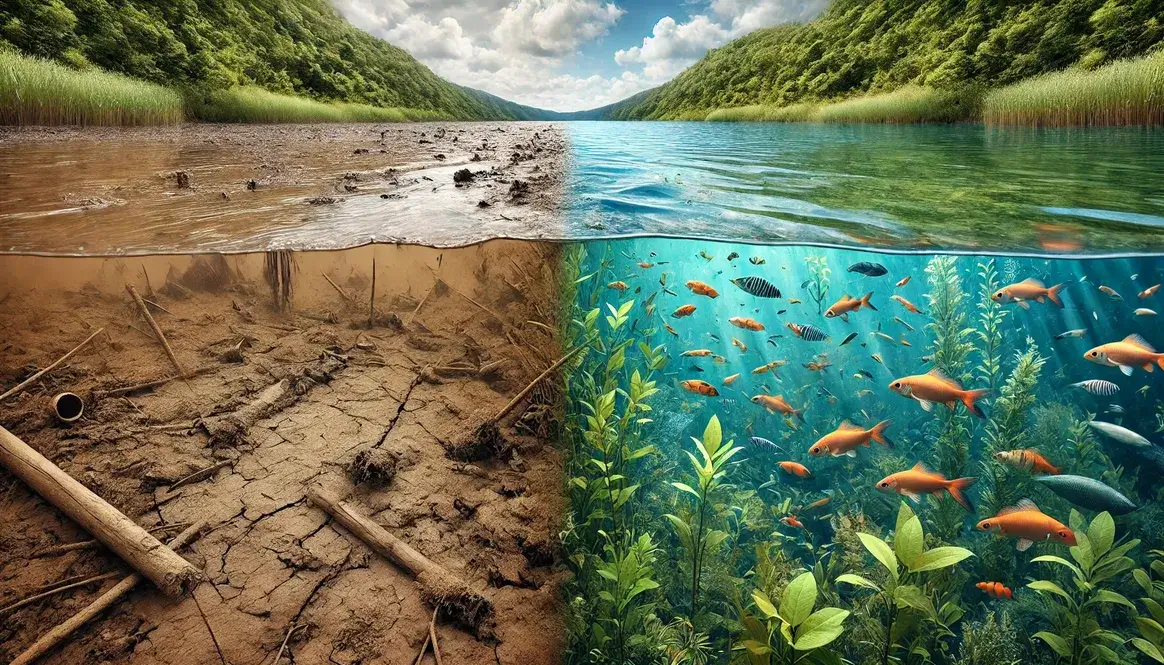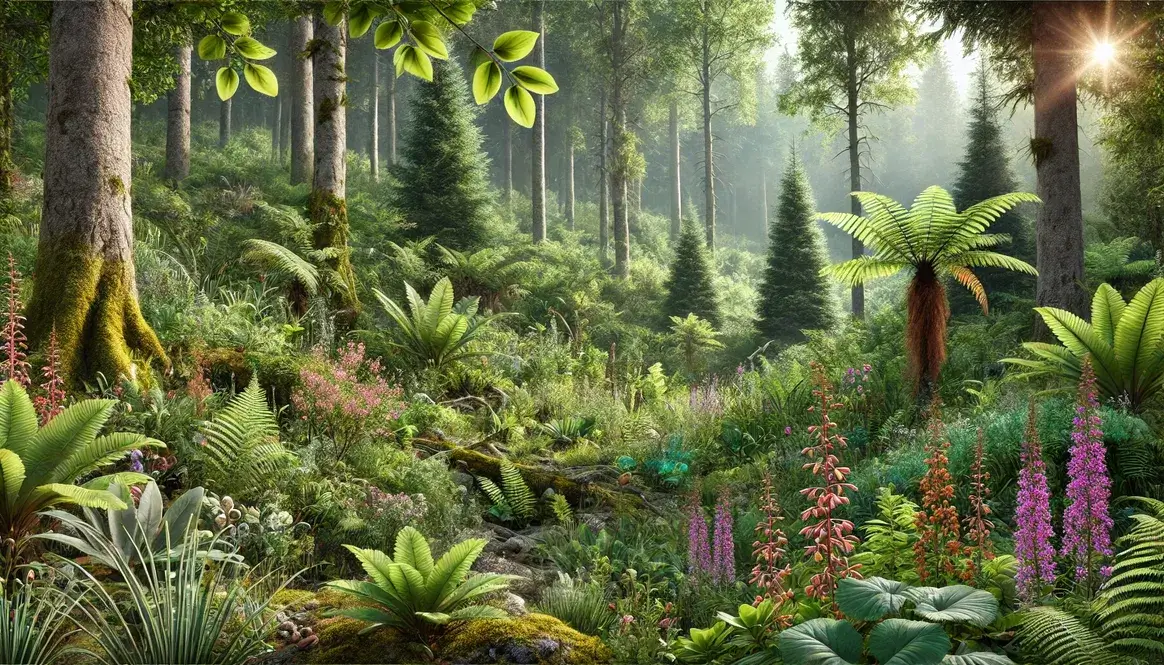The Mesozoic Era, when dinosaurs ruled the Earth, had a climate very different from what we experience today. This period, lasting from about 252 to 66 million years ago, was generally warmer and more humid than our current world.
During dinosaur times, the Earth’s average temperature was significantly higher. There were no polar ice caps, and even areas near the poles were warm enough to support lush forests. The atmosphere contained much more carbon dioxide than it does now, creating a strong greenhouse effect.
This warmer, more humid climate had a big impact on the types of plants that grew and the environments where dinosaurs lived. Forests were more extensive, reaching farther north and south than they do today. Deserts were less common, and many areas that are now dry were covered in lush vegetation.
| Key Takeaways: Storms and Weather in Dinosaur Times | |
|---|---|
| Climate | Warmer, more humid, with higher CO2 levels |
| Storm Frequency | Potentially more frequent and intense tropical storms |
| Extreme Weather | Hurricanes, thunderstorms, tornadoes, and monsoons |
| Impact on Dinosaurs | Influenced behavior, migration, and habitat selection |
| Evidence | Fossil records, geological indicators, computer models |
Storms and Weather in Dinosaur Times: An Overview
The unique climate of the Mesozoic Era led to weather patterns that were both similar to and different from what we see today. Storms and weather in dinosaur times were influenced by the warmer temperatures and higher humidity levels.
Types of weather events during the Mesozoic included:
- Tropical storms and hurricanes
- Thunderstorms and lightning
- Tornadoes
- Monsoons and heavy rainfall
- Droughts and dry spells
While these weather events might sound familiar, their frequency and intensity were likely different from what we experience in the modern world. For example, the warmer oceans of the Mesozoic may have fueled more powerful and frequent hurricanes.
Compared to modern weather patterns, the Mesozoic climate had fewer extremes between seasons. The lack of ice caps meant there were no large, cold air masses to create the intense winter storms we see today. However, the increased heat and moisture in the atmosphere likely led to more intense summer storms and rainfall events.
Understanding storms and weather in dinosaur times helps us piece together the daily lives of these ancient creatures. It also provides valuable insights into how climate affects life on Earth, both in the past and in our changing world today.
Extreme Weather Events in the Age of Dinosaurs
The Mesozoic Era wasn’t just a time of giant reptiles roaming the Earth. It was also a period of intense and dramatic weather events that shaped the world dinosaurs lived in. Let’s explore some of the most extreme weather phenomena that occurred during this fascinating time in Earth’s history.
Prehistoric Hurricanes and Typhoons
Hurricanes and typhoons in the age of dinosaurs were likely more frequent and intense than those we experience today. This increased storm activity was primarily due to the warmer Cretaceous climate, which provided more energy for these massive storms to form and grow.
Here’s how prehistoric hurricanes compared to modern ones:
| Feature | Prehistoric Hurricanes | Modern Hurricanes |
|---|---|---|
| Frequency | More frequent | Less frequent |
| Intensity | Potentially stronger | Variable intensity |
| Size | Possibly larger | Variable size |
| Duration | Longer-lasting | Shorter duration |
The warmer oceans of the Mesozoic Era provided more fuel for these storms, allowing them to grow larger and last longer than many of their modern counterparts. These powerful storms would have had a significant impact on dinosaur habitats, potentially altering landscapes and influencing migration patterns.
Ancient Thunderstorms and Lightning
Thunderstorms were also a common occurrence during dinosaur times. The warm, humid climate of the Mesozoic Era created perfect conditions for the development of these electrical storms.
Evidence for ancient thunderstorms can be found in the fossil record. Scientists have discovered:
- Fulgurites: These are glass-like tubes formed when lightning strikes sand or soil, fusing the particles together.
- Charred wood: Lightning-struck trees preserved in the fossil record provide evidence of ancient electrical storms.
The frequent occurrence of thunderstorms likely had a significant impact on dinosaur behavior. Just like modern animals, dinosaurs probably sought shelter during these intense weather events. Some paleontologists speculate that certain dinosaur behaviors, such as herding, might have evolved partly as a response to the need for protection during violent storms.
Interestingly, the high levels of carbon dioxide in the Cretaceous atmosphere may have contributed to more frequent and intense lightning storms. This is because carbon dioxide can act as an insulator, allowing greater charge separation in storm clouds and resulting in more powerful lightning strikes.
These ancient thunderstorms not only affected dinosaur behavior but also played a role in shaping the landscape and ecosystems of the Mesozoic Era. Lightning-induced wildfires, for example, would have been a common occurrence, influencing plant growth and creating new habitats for various dinosaur species.
Tornadoes in the Mesozoic
While direct evidence of tornadoes from the age of dinosaurs is scarce, scientists believe these powerful wind events likely occurred during the Mesozoic Era. The warm, humid climate and the presence of large land masses created conditions favorable for tornado formation.
Tornado occurrence in dinosaur times probably varied depending on:
- Geographical location
- Seasonal temperature fluctuations
- Atmospheric instability
The effects of tornadoes on dinosaur habitats could have been significant:
- Habitat destruction: Tornadoes could have uprooted trees and reshaped landscapes.
- Food source disruption: Damaged vegetation might have temporarily reduced food availability for herbivorous dinosaurs.
- New ecological niches: Tornado damage could have created new habitats, promoting biodiversity.
Rainfall Patterns During Dinosaur Times
The Mesozoic Era saw rainfall patterns quite different from those we experience today. These patterns played a crucial role in shaping the environments where dinosaurs lived and thrived.
Monsoon Seasons in the Mesozoic
Evidence suggests that monsoon seasons were a significant feature of the Mesozoic climate. These periods of heavy, seasonal rainfall had a profound impact on the flora and fauna of the time.
Geological records provide clues about these ancient monsoons:
- Sedimentary layers in rocks show alternating wet and dry periods
- Plant fossils indicate adaptations to seasonal rainfall
- Ancient soil samples reveal patterns consistent with monsoon climates
The impact of these monsoon seasons was far-reaching:
Plant Growth: Monsoons likely led to explosive plant growth during wet seasons. This abundance of vegetation would have provided ample food for herbivorous dinosaurs. The Cretaceous plant adaptations we see in the fossil record often show features that helped them thrive in these alternating wet and dry conditions.
Dinosaur Migration: The seasonal nature of monsoon rains may have influenced dinosaur migration patterns. Some species might have followed the rains to take advantage of lush vegetation, while others may have moved to avoid flooded areas. This seasonal movement would have been crucial for dinosaur climate migration, allowing them to access food sources year-round.
These monsoon patterns, combined with other weather phenomena, created a dynamic and ever-changing environment for dinosaurs. Understanding these rainfall patterns helps us paint a more vivid picture of what life was like for these ancient creatures and how they adapted to their ever-changing world.
Droughts and Dry Spells
While the Mesozoic Era was generally warm and humid, it wasn’t without its dry periods. Extended droughts and dry spells were part of the climate patterns that dinosaurs had to contend with. These periods of water scarcity played a significant role in shaping dinosaur behavior and evolution.
Evidence for droughts in the age of dinosaurs comes from several sources:
- Fossil soils (paleosols) showing signs of prolonged dryness
- Plant fossils with adaptations to arid conditions
- Sedimentary deposits indicating periods of reduced rainfall
Dinosaurs developed various strategies to cope with these challenging times:
Water Conservation: Many dinosaur species likely evolved physiological adaptations to conserve water. This might have included:
- More efficient kidneys
- Reduced water loss through skin
- Ability to concentrate urine
Behavioral Adaptations: Dinosaurs probably altered their behavior during dry spells. This could have involved:
- Seeking shade during the hottest parts of the day
- Congregating around remaining water sources
- Digging for water in dry riverbeds
Some dinosaurs may have even aestivated – entering a state of dormancy during hot, dry periods, similar to how some modern animals hibernate during cold winters.
Dietary Adjustments: During droughts, dinosaurs likely had to adjust their diets. Herbivores might have turned to more succulent plants or even eaten bark to obtain moisture. Carnivores may have relied more heavily on the body fluids of their prey for hydration.
It’s worth noting that the ability to adapt to these dry spells varied among different dinosaur species. This variability in drought tolerance likely influenced which species thrived in certain environments and may have played a role in the Arctic dinosaur adaptations we see in the fossil record.
Understanding how dinosaurs coped with droughts and dry spells gives us valuable insights into their resilience and adaptability. It also helps us appreciate the complex interplay between climate and evolution in shaping the incredible diversity of dinosaur species that once roamed our planet.
Winds in the Dinosaur Era
The winds that swept across the Earth during the Mesozoic Era played a crucial role in shaping the world of dinosaurs. These ancient breezes influenced everything from climate patterns to the spread of plants and even the flight capabilities of flying reptiles.
Prevailing Wind Patterns
During the dinosaur era, the Earth’s wind patterns were influenced by several factors:
- Continental arrangement
- Global temperature gradients
- Ocean currents
The supercontinent Pangaea, which existed at the beginning of the Mesozoic, gradually broke apart over millions of years. This changing geography had a significant impact on wind patterns. As landmasses shifted, new wind corridors opened up, altering climate patterns across the globe.
One notable feature of Mesozoic wind patterns was the presence of strong trade winds. These consistent easterly winds near the equator would have influenced rainfall patterns and helped distribute heat around the planet. The Cretaceous ocean currents were closely tied to these wind patterns, creating a complex system of global circulation.
Impact on Dinosaur Ecosystems and Behavior
The winds of the Mesozoic had far-reaching effects on dinosaur life:
Seed Dispersal: Wind played a crucial role in spreading plant seeds, helping to distribute food sources for herbivorous dinosaurs. This was particularly important as flowering plants began to evolve and diversify during the Cretaceous period.
Climate Influence: Winds affected local and regional climates, creating diverse habitats that supported different dinosaur species. For example, coastal areas might have experienced more moderate temperatures due to sea breezes, while inland areas could have had more extreme temperature fluctuations.
Flying Adaptations: For pterosaurs and early birds, understanding and utilizing wind patterns was crucial. These flying creatures likely took advantage of updrafts and thermal currents to soar efficiently, much like modern birds do.
Wind also had indirect effects on dinosaur behavior:
- Migration: Strong seasonal winds might have influenced dinosaur migration patterns, as they followed food sources or sought more favorable climates.
- Nesting: Some dinosaurs may have chosen nesting sites based on wind protection, similar to how modern animals seek shelter for their young.
- Hunting and Foraging: Wind direction could have affected how dinosaurs hunted or foraged, as it would influence how scents traveled.
Understanding the wind patterns of the Mesozoic helps us piece together a more complete picture of the dinosaur world. It reminds us that these ancient creatures, like modern animals, were intimately connected to the environmental forces around them. By studying these patterns, scientists can better understand how dinosaurs lived, moved, and evolved in response to their ever-changing environment.
Temperature Fluctuations and Dinosaurs
While the Mesozoic Era was generally warmer than today, dinosaurs still experienced significant temperature fluctuations. These changes in heat and cold played a crucial role in shaping dinosaur behavior and evolution.
Heatwaves in Prehistoric Times
Extreme heat events were likely common during the age of dinosaurs. The warm global climate, combined with high levels of greenhouse gases, created conditions ripe for intense heatwaves.
Occurrence of extreme heat events:
- More frequent in equatorial regions
- Intensified during periods of increased volcanic activity
- Varied in duration, from days to possibly weeks
How did dinosaurs cope with these scorching temperatures? Scientists believe they employed several strategies:
- Behavioral adaptations: Dinosaurs may have sought shade or water during the hottest parts of the day, similar to modern animals in hot climates.
- Physiological adaptations: Some dinosaurs might have had specialized blood vessels or nasal passages to help cool their bodies.
- Nocturnal activity: Certain species possibly became more active at night to avoid daytime heat.
Interestingly, some researchers suggest that the largest dinosaurs, like sauropods, might have been better equipped to handle heat due to their size. Their large body mass could have acted as a heat sink, helping them maintain a stable internal temperature despite external fluctuations.
Cold Snaps and Frost
While the Mesozoic was generally warm, evidence suggests that colder periods did occur, especially at higher latitudes. These cold snaps would have presented unique challenges for dinosaurs.
Evidence for colder periods:
- Geological records showing seasonal temperature variations
- Plant fossils indicating adaptations to colder climates
- Sediment deposits suggesting periodic freezing
Dinosaurs living in these colder regions developed various adaptations:
- Insulation: Some dinosaurs likely had feathers or fur-like coverings for warmth.
- Metabolic adjustments: Certain species may have been able to lower their metabolic rate during colder periods.
- Migration: Evidence suggests some dinosaurs migrated seasonally to avoid the harshest cold.
The discovery of dinosaur fossils in what was once the polar regions has shed light on how these ancient creatures adapted to colder climates. For instance, Arctic dinosaur species show unique adaptations like larger eyes for seeing in the long polar nights and possibly even methods of storing fat for the leaner winter months.
These temperature fluctuations, both hot and cold, played a significant role in shaping dinosaur evolution and behavior. By studying how dinosaurs adapted to these changes, we gain valuable insights into their resilience and the diversity of environments they were able to inhabit. This understanding not only enriches our knowledge of prehistoric life but also provides perspective on how modern animals might adapt to changing climates.
Impact of Weather on Dinosaur Life
Weather played a crucial role in shaping the lives of dinosaurs, influencing their behavior, habitats, and even their long-term evolution. Let’s explore how the ancient climate affected these prehistoric giants.
Weather and Dinosaur Behavior
The daily activities of dinosaurs were closely tied to weather patterns. Just like modern animals, dinosaurs likely adjusted their behavior based on the weather conditions they faced.
During hot periods, many dinosaurs probably sought shelter during the warmest parts of the day. They might have:
- Rested in the shade of large trees
- Wallowed in mud or shallow water to cool off
- Become more active during cooler morning and evening hours
Rainy seasons would have brought about different behaviors. Herbivorous dinosaurs may have taken advantage of the lush vegetation that sprouted after rains, while carnivores might have found hunting easier in the denser plant growth.
Weather also influenced larger-scale dinosaur movements. Seasonal climate changes likely triggered migrations in some dinosaur species. These journeys could have been driven by:
- Search for food and water during dry seasons
- Avoidance of harsh weather conditions
- Pursuit of optimal breeding grounds
Evidence for these migrations can be found in fossil trackways and in the distribution of dinosaur remains across different paleoenvironments.
Weather Effects on Dinosaur Habitats
Weather patterns had a profound impact on the landscapes dinosaurs called home. These effects ranged from subtle changes in vegetation to dramatic alterations of entire ecosystems.
Changes in vegetation due to weather patterns:
The plant life that sustained herbivorous dinosaurs was directly influenced by weather conditions. During wet periods, lush forests and grasslands would have thrived, providing abundant food. Dry spells, on the other hand, would have led to more sparse vegetation, potentially causing food scarcity for some species.
Extreme weather events could have more dramatic effects:
- Storms might have felled trees, creating clearings in forests
- Floods could have deposited nutrient-rich silt, promoting plant growth
- Extended droughts may have led to the spread of more drought-resistant plants
These changes in vegetation would have rippled through the entire ecosystem, affecting herbivores and, in turn, the carnivores that preyed upon them.
Erosion and landscape changes caused by weather:
Weather was a powerful force in shaping the physical landscape of the dinosaur world. Wind and water erosion carved out valleys, created river systems, and shaped coastlines. These processes could happen gradually over long periods or rapidly during extreme weather events.
For example, heavy rains might have caused:
- Landslides that altered hillsides and mountain slopes
- Flash floods that carved new channels and deposited sediment
- Erosion of softer rock layers, exposing new surfaces
These landscape changes had significant impacts on dinosaur habitats. They could create new areas for nesting, alter migration routes, or even isolate populations, potentially leading to the evolution of new species over time.
Understanding the impact of weather on dinosaur life helps us piece together a more complete picture of these ancient creatures and their world. It reminds us that, like modern animals, dinosaurs were intimately connected to their environment, adapting and evolving in response to the ever-changing conditions around them.
Uncovering Ancient Weather: Scientific Methods
Piecing together the weather patterns of the dinosaur era is like solving a complex puzzle. Scientists use a variety of ingenious methods to uncover clues about the ancient climate. Let’s explore some of these fascinating techniques.
Fossil Evidence of Prehistoric Weather
Fossils are time capsules that contain a wealth of information about ancient environments, including weather patterns. Here’s how scientists use fossils to learn about prehistoric climate:
- Plant fossils: The structure of fossilized leaves can indicate rainfall amounts and temperature ranges.
- Animal fossils: The distribution and types of animal fossils found in an area can suggest what the climate was like.
- Growth rings: Similar to tree rings, some fossils show annual growth patterns that reflect seasonal changes.
Specific examples of weather events preserved in the fossil record include:
- Raindrop impressions: Rare fossils of raindrops preserved in mud can indicate the intensity of ancient rainstorms.
- Flood deposits: Layers of sediment showing signs of rapid deposition can indicate flooding events.
- Windblown sand dunes: Fossilized sand dunes provide information about wind patterns and strength.
One fascinating example is the discovery of fossilized raindrop impressions in 2.7 billion-year-old rocks in South Africa. These ancient raindrops help scientists understand the density of the Earth’s atmosphere in the distant past.
Geological Indicators of Mesozoic Weather
Rocks and sediments from the Mesozoic era are like pages in Earth’s history book, revealing stories about ancient weather patterns. Scientists use various techniques to read these geological clues:
Rock formations and sediments:
- Varves: These annual layers in lake sediments can indicate seasonal changes in rainfall.
- Evaporite deposits: Minerals left behind when water evaporates suggest periods of drought.
- Glacial deposits: While rare in the Mesozoic, these can indicate colder periods.
Chemical analysis techniques: Scientists use sophisticated methods to analyze the chemical composition of rocks and fossils, providing insights into ancient climates:
- Oxygen isotope analysis: The ratio of different oxygen isotopes in fossils can indicate temperature at the time the organism lived.
- Carbon isotope analysis: This can reveal information about atmospheric CO2 levels and plant productivity.
- Leaf wax biomarkers: Chemical compounds preserved in ancient leaves can provide data on rainfall patterns.
These techniques have revealed fascinating details about the Mesozoic climate. For example, computer weather simulations based on geological data have helped scientists reconstruct the intense monsoons that likely occurred during the Cretaceous period.
By combining evidence from fossils, rock formations, and chemical analyses, scientists can paint a vivid picture of the weather patterns that dinosaurs experienced. This multidisciplinary approach allows us to understand not just what the climate was like millions of years ago, but also how it changed over time and influenced the evolution of life on Earth.
Weather’s Role in Dinosaur Evolution
Weather and climate changes played a crucial role in shaping dinosaur evolution over millions of years. As environmental conditions shifted, dinosaurs adapted in remarkable ways to survive and thrive.
How weather drove adaptations:
- Temperature fluctuations led to changes in body size and insulation.
- Varying rainfall patterns influenced feeding strategies and migration behaviors.
- Extreme weather events created selective pressures for resilient traits.
Examples of dinosaur features possibly influenced by weather conditions include:
- Feathers: Originally evolved for insulation, feathers later became crucial for flight in some dinosaur lineages.
- Nasal passages: Some dinosaurs developed complex nasal structures that may have helped regulate body temperature in hot climates.
- Frills and plates: These structures in certain dinosaurs might have served as thermal regulators, helping to cool or warm the body.
The rapid climate changes at the end of the Cretaceous period likely played a significant role in the extinction of non-avian dinosaurs. This event highlights the profound impact that weather and climate can have on the course of evolution.
Conclusion
Storms and weather in dinosaur times were dynamic forces that shaped the world these ancient creatures inhabited. From intense hurricanes to scorching heatwaves, the Mesozoic climate presented numerous challenges and opportunities for dinosaurs.
By studying the evidence left behind in rocks and fossils, scientists have pieced together a fascinating picture of the prehistoric climate. This knowledge not only helps us understand how dinosaurs lived and evolved but also provides valuable insights into Earth’s climate system and how it changes over time.
As we face our own era of climate change, the story of dinosaurs and their weather reminds us of the powerful link between climate and the evolution of life on Earth. It underscores the importance of understanding and respecting the forces of nature that have shaped our planet’s history and continue to influence its future.









